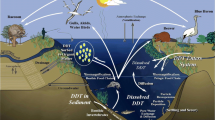Abstract
Four paddy herbicides and their transformation products (TPs) were monitored in the Sakura River, Japan, during the rice growing seasons of 2009 and 2010. Toxicity tests to an attached diatom, Mayamaea atomus, and a green alga, Pseudokirchneriella subcapitata, were also conducted. Clomeprop propionic acid, which forms from the degrading herbicide, was detected in the river water at much higher concentrations than the parent compound (the maximum concentration of the TP and the parent compound; 0.829–0.925 μg/L and 0.039–0.073 μg/L, respectively). The toxicity of the TPs to the diatom and green alga was relatively low; the 72-h median effective concentration (EC50) value > 1,470 μg/L; for each compound, the maximum concentration in the river did not exceed the EC50 value.

Similar content being viewed by others
References
Day KE (1991) Pesticide transformation products in surface waters. In: Somasundaram L, Coats JR (eds) Pesticide transformation products: fate and significance in the environment. ACS Symposium Series No. 459, 217–241, Washington, DC
Environment Canada (1992) Biological test method: growth inhibition test using the freshwater alga Selenastrum capriconutum. Report EPS 1/RM/25. Environment Canada, Ottawa
Food and Agricultural Materials Inspection Center (2008) http://www.acis.famic.go.jp/syouroku/bromobutide/bromobutide_01.pdf (in Japanese)
Food and Agricultural Materials Inspection Center (2009) http://www.acis.famic.go.jp/syouroku/cafenstrole/cafenstrole_01.pdf (in Japanese)
Ishihara S (2008) Development of risk assessment procedure for evaluating effect of herbicides on primary productivity of river ecosystem. Bull Natl Inst Agro Environ Sci 25:1–92
Iwafune T, Inao K, Horio T, Iwasaki N, Yokoyama A, Nagai T (2010) Behavior of paddy pesticides and major metabolites in the Sakura River, Ibaraki, Japan. J Pestic Sci 35:114–123
Kawakami T, Ishizaka M, Ishii Y, Eun H, Miyazaki J, Tamura K, Higashi T (2005) Concentration and distribution of several pesticides applied to paddy fields in water and sediment, from Sugao Marsh, Japan. Bull Environ Contam Toxicol 74:954–961
Kobayashi K, Tsukasaki Y, Tongma S, Shim LS (1999) Phytotoxic activity of clomeprop in soil and concentration of its hydrolysed metabolite DMPA in soil water. Pestic Sci 55:474–478
Lange-Bertalot H (2001) Diatoms of Europe vol 2. A.R.G. Ganter Verlag K.G. Ruggell
Lewis MA (1995) Algae and vascular plant tests. In: Rand GM (ed) Fundamentals of aquatic toxicology second edition: effects, environmental fate, and risk assessment. Taylor and Francis, Philadelphia, pp 135–161
Maltby L, Arnold D, Arts G, Davies J, Heimbach F, Pickl C, Poulsen V (2010) Aquatic macrophyte risk assessment for pesticides. CRC Press, New York
Mitobe H, Ibaraki T, Tanabe A, Kawata K, Sakai M, Kifune I (1999) Variation of pesticides in a river through paddy fields area. J Environ Chem 9:311–320
Stratton GW (1984) Effects of the herbicide atrazine and its degradation products, alone and in combination, on phototrophic microorganism. Arch Environ Contam Toxicol 13:35–42
Sudo M, Kunimatsu T, Okubo T (2002) Concentration and loading of pesticide residues in Lake Biwa basin (Japan). Water Res 36:315–329
Takahashi N, Mikami N, Yamada H, Miyamoto J (1985) Photodegradation of the herbicide bromobutide in water. J Pestic Sci 10:247–256
Watanabe M, Kasai F, Sudo R (1988) NIES collection list of strains. Second edition Micro and protozoa. National Institute for Environmental Studies, Tsukuba, p 148
Wei L, Yu H, Sun Y, Fen J, Wang L (1998) The effects of three sulfonylurea herbicides and their degradation products on the green algae Chlorella pyrenoidosa. Chemosphere 37:747–751
Acknowledgments
We thank Y. Yogo, Y. Iizumi, M. Abe, K. Watanabe, Y. Tajima, K. Hamaguchi, and S. Nagasaki of National Institute for Agro-Environmental Sciences, for providing advice on our study and help with sample collection. This study was supported in part by a Grant for Environment Research Projects from the Sumitomo Foundation (No. 083169).
Author information
Authors and Affiliations
Corresponding author
Rights and permissions
About this article
Cite this article
Iwafune, T., Ara, T., Ishihara, S. et al. Investigation of Concentrations of Paddy Herbicides and Their Transformation Products in the Sakura River, Japan, and Toxicity of the Compounds to a Diatom and a Green Alga. Bull Environ Contam Toxicol 88, 38–42 (2012). https://doi.org/10.1007/s00128-011-0416-7
Received:
Accepted:
Published:
Issue Date:
DOI: https://doi.org/10.1007/s00128-011-0416-7




